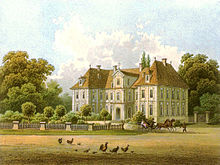Wrocław-Krzyki (City District)
Wrocław-Krzyki (Krieter) or simply Krzyki (Krieter) is a district in the south and south-east of the city of Wroclaw in the Polish Lower Silesian Voivodeship .
General
Since 1990, the smaller city districts ( pl.Osiedle ) have gained in importance in Polish local politics , but a city district like Krzyki still has some city district authorities such as its own financial authority (pl. Urząd Skarbowy ), a health department or a police headquarters .
Since the Red Army stormed the fortress of Breslau from the south and the west in 1945 , the inner-city districts of the Krzyki / Krieter district (former Wilhelm quarter) were almost completely destroyed. After the war they were built on with prefabricated housing estates.
An area on the main street Aleja Powstańców Śląskich (Kaiser-Wilhelm-Straße or “Straße der SA” during the Nazi era), approx. 1.5 km from the market square, remains undeveloped. On the southern edge of this area, the Poltegor skyscraper was demolished in 2007 (with a roof height of 92 m it was the highest skyscraper in the city to date), on the northern edge the largest hotel in the city ( Hotel Wrocław ), but all plans for the construction of a new southern center on the several hectares of space between these buildings remain unrealized.
In the south of the borough are some of the city's preferred residential areas, especially the districts of Ołtaszyn / Oltaschin and Wojszyce / Woischwitz .
In the former suburb of Klettendorf (now the Klecina district ) there was one of the most important sugar factories until 1945 , in which the fine sugar Klettendorfer refined sugar , known throughout Germany and in neighboring countries , was produced. The company operating under Vom Rath, Schoeller & Skene had grown through mergers with other sugar factories in the district of Breslau (e.g. Koberwitz , Kreika ).
Urban district structure

The districts of the Krzyki / Krieter district are (in brackets the year of incorporation into Wrocław or Breslau):
- Bieńkowice / Benkwitz (1951)
- Bierdzany / Pirscham (1928)
- Borek / Kleinburg (1897)
- Brockau / Brockau (1951)
- Dworek / Höfchen (1868)
- Gaj / Herdain (1904)
- Huby / Huben (1868) with formerly independent Glinianki (clay pits) and Pola Stawowe (pond fields)
- Jagodno / Lamsfeld (1951)
- Klecina / Klettendorf (1951)
- Krzyki / Krieter (1928)
- Książe Małe / Klein Tschansch ( 1937–1945: Klein Ohlewiesen ) (1928)
- Książe Wielkie / Groß Tschansch ( 1937–1945: Groß Ohlewiesen ) (1928)
- Lamowice Stare / Alt-Lammerwitz (1951)
- Nowy Cathedral / Neuhaus (1928)
- Ołtaszyn / Oltaschin ( 1937–1945: Herzogshufen ) (1951)
- Opatowice / Ottwitz (1928)
- Partynice / Hartlieb (1928)
- Południe / Kaiser Wilhelm Quarter (1868)
- Przedmieście Oławskie / Ohleviertel (1808)
- Rakowiec / Morgenau (1808 and 1904)
- Siedlec / Zedlitz (1904)
- Świątniki / Schweitnig (1928)
- Tarnogaj / Dürrgoy (1904)
- Wilczy Kąt / Wolfswinkel (1808)
- Wojszyce / Woischwitz ( 1937–1945: Hoinstein ) (1951)
Individual evidence
- ↑ Daria Dorota Pikulska: Carl Johann Christian Zimmermann . Wrocław 2005, ISBN 83-8926221-5 .
- ^ Encyclopedia Wrocławia . Wrocław 2000, ISBN 83-7023-749-5 , p. 669 .

